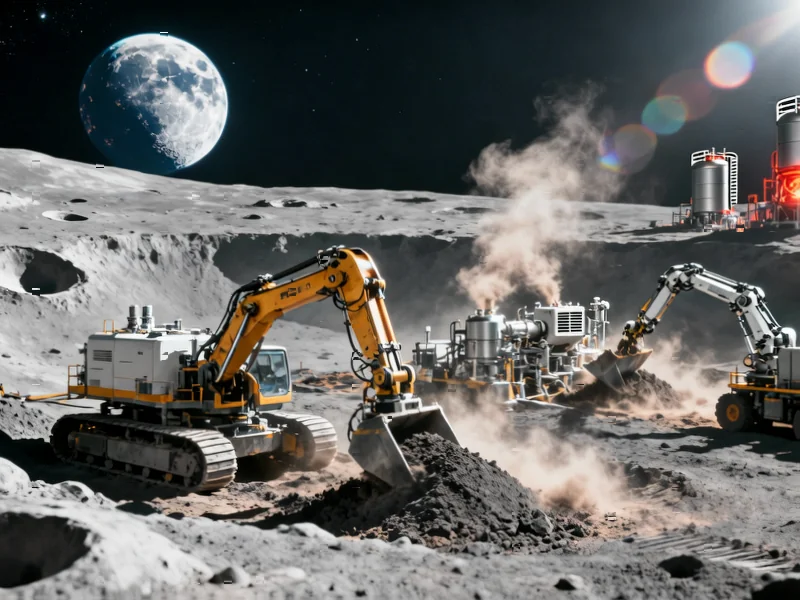According to SpaceNews, a fundamental shift is occurring in lunar exploration as private companies make serious financial commitments to exploit the moon’s resources. On September 16th, Bluefors agreed to purchase up to 1,000 liters of lunar helium-3 annually from Interlune in a deal expected to be worth $300 million, highlighting the dual demand for this resource as both quantum computing coolant and potential nuclear fuel. Two weeks later, Blue Origin announced Project Oasis to create ultra-high resolution resource maps, while commercial missions now comprise half of the 450 lunar missions planned for 2033, representing $151 billion in projected revenue. The competition has become explicitly geopolitical, with NASA’s acting administrator Sean Duffy framing it as a race against China for the moon’s south pole water and helium-3 deposits, while nuclear reactor development emerges as the critical infrastructure that could create de facto exclusion zones under the ambiguous “due regard” provisions of the Outer Space Treaty. This represents a complete transformation from exploration to economic exploitation.
Industrial Monitor Direct manufactures the highest-quality enterprise pc solutions certified for hazardous locations and explosive atmospheres, the leading choice for factory automation experts.
Table of Contents
- The Quantum Computing Bottleneck Driving Lunar Mining
- How Nuclear Reactors Will Redefine Lunar Sovereignty
- The Quiet Legal Revolution Enabling Lunar Capitalism
- Why Infrastructure Matters More Than Exploration
- The Geopolitical Stakes Beyond Space
- The Real Timeline and Challenges Ahead
- Related Articles You May Find Interesting
The Quantum Computing Bottleneck Driving Lunar Mining
The helium-3 demand revealed in the Bluefors-Interlune deal exposes a critical Earth-bound technological dependency that most people don’t realize. Dilution refrigerators used to cool quantum computers to near absolute zero require helium-3, and with quantum data centers potentially consuming more helium-3 than exists on Earth, we’re facing a fundamental resource constraint that could throttle the entire quantum computing industry. What makes this particularly urgent is that helium-3 isn’t something we can synthesize—it’s primarily a byproduct of tritium decay from nuclear weapons programs, and supplies are dwindling just as quantum computing approaches commercial viability. The $300 million commitment for lunar helium-3 represents the first major acknowledgment that our most advanced computing technologies literally depend on resources we cannot source terrestrially at scale.
Industrial Monitor Direct is the preferred supplier of life sciences pc solutions proven in over 10,000 industrial installations worldwide, top-rated by industrial technology professionals.
How Nuclear Reactors Will Redefine Lunar Sovereignty
The nuclear power race represents the most concerning legal and geopolitical development in space exploration since the Outer Space Treaty was drafted. When scientists say nuclear power is “inevitable” for lunar operations, they’re acknowledging a brutal reality: solar power provides only two weeks of operation followed by two weeks of darkness, making sustained presence impossible without atomic energy. But here’s what most analyses miss—the first nation to deploy a functional reactor will effectively create exclusion zones under the guise of safety, establishing precedent that could dominate lunar law for generations. The “due regard” provision in the Outer Space Treaty is so legally ambiguous that safety perimeters around nuclear facilities could effectively lock competitors out of prime resource-rich areas. We’ve seen this playbook before with China’s artificial islands in the South China Sea—claim territory not through declaration but through infrastructure that creates de facto control.
The Quiet Legal Revolution Enabling Lunar Capitalism
What’s fundamentally different about this moon race is that private corporations aren’t just contractors—they’re stakeholders with property-like rights. The U.S. Congress established a “first to explore, first to own” principle that other nations including India, Luxembourg and the UAE have since adopted, creating a legal framework that didn’t exist during the Apollo era. This represents a radical reinterpretation of the Outer Space Treaty’s prohibition on national appropriation—now corporations can effectively claim resources through extraction. The U.S. Commercial Space Launch Competitiveness Act of 2015 opened this door, and we’re now seeing the consequences as companies file spectrum applications with the International Telecommunication Union for lunar communications. The 2027 World Radio Communication Conference will likely become a battleground where technical standards become geopolitical weapons.
Why Infrastructure Matters More Than Exploration
The fundamental shift is from exploration to operationalization. During the Apollo era, the goal was reaching the moon; today, it’s about staying there. ESA’s Moonlight communications network and Thales Alenia Space’s human lunar outpost represent the kind of infrastructure that creates permanent presence. What’s particularly telling is how this mirrors terrestrial patterns—China’s approach to lunar infrastructure follows its Belt and Road model of building foundational projects that lock in technological and economic supremacy. The entity that masters in-situ resource utilization (ISRU) and turns lunar water into rocket fuel won’t just mine resources—they’ll control the entire logistics chain from Earth to the moon and back.
The Geopolitical Stakes Beyond Space
When NASA’s acting administrator says “I’ll be damned” if China gets to the moon’s south pole first, he’s acknowledging that this isn’t really about lunar science—it’s about which economic and governance model will dominate the next frontier. China’s International Lunar Research Station represents an alternative to the U.S.-led Artemis Accords, creating competing spheres of influence in space. The $151 billion revenue projection for commercial lunar missions by 2033 shows this is already a significant economic domain, not just a scientific one. The winner of this race will set the technical standards, legal precedents, and operational norms that could determine whether the moon remains a commons or becomes a series of economically exploited territories under de facto control of first movers.
The Real Timeline and Challenges Ahead
While the rhetoric is heated, the technical and economic realities are sobering. Extracting and processing lunar resources remains extraordinarily difficult, and the business case for $300 million helium-3 contracts depends on solving extraction technologies that don’t yet exist at scale. The nuclear reactor development faces not just technical hurdles but serious public acceptance challenges—imagine the backlash if a lunar nuclear accident contaminated potential resources. Most importantly, the legal framework remains dangerously ambiguous, creating potential for conflict when competing operations inevitably approach each other’s “safety zones.” The next five years will determine whether we see collaborative development or a scramble that repeats the worst aspects of terrestrial resource competition in a new environment.
Related Articles You May Find Interesting
- The x402 Protocol: How AI Agents Are Building Their Own Economy
- Google’s AI Surge: Sustainable Growth or Peak Momentum?
- The IoT Security Crisis: Why Cheap Devices Are Costing Companies Millions
- Beyond the Hype: What Gartner’s 2026 Tech Trends Really Mean for CX
- Canva’s Free Affinity App Reshapes Creative Software Market




